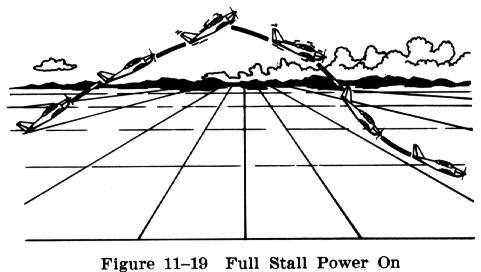
Power on stall recoveries are practiced from straight climbs, and climbing turns with 15 to 20 degree banks, to simulate an accidental stall occurring during takeoffs and departure climbs. Therefore, airplanes equipped with flaps and/or retractable landing gear normally should be in the takeoff configuration. However, power on stalls should also be practiced with the airplane in a clean configuration (flaps and/or gear retracted) as in departure and normal climbs (Fig. 11-19).

After establishing the takeoff or departure configuration, the airplane should be slowed to the normal liftoff speed while clearing the area for other air traffic. When the desired speed is attained, the power should be set at takeoff power for the takeoff stall or the recommended climb power for the departure stall while establishing a climb attitude. The purpose of reducing the speed to liftoff speed before the throttle is advanced to the recommended setting is to avoid an excessively steep nose up attitude for a long period before the airplane stalls.
After the climb attitude is established, the nose is then brought smoothly upward to an attitude obviously impossible for the airplane to maintain and is held at that attitude until the full stall occurs. In most airplanes it will be found that after attaining the stalling attitude, the elevator control must be moved progressively further back as the airspeed decreases until, at the full stall, it will have reached its limit and cannot be moved back farther.
Recovery from the stall should be accomplished by immediately reducing the angle of attack by positively releasing back elevator pressure and smoothly advancing the throttle to maximum allowable power. In this case, however, since the throttle is already at the climb power setting, the addition of power will be relatively slight.
The nose should be lowered as necessary to regain flying speed. Then the airplane should be returned to the normal straight and level flight attitude. When in normal level flight, the throttle should be returned to cruise power setting.
The pilot must recognize instantly when the stall has occurred and take prompt action to prevent a prolonged stalled condition. Performance is unsatisfactory if a secondary stall occurs, or if the pilot fails to take proper action to avoid excessive airspeed, excessive loss of altitude, or a spin.